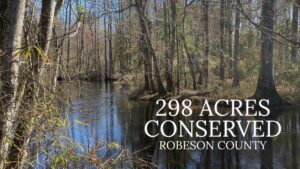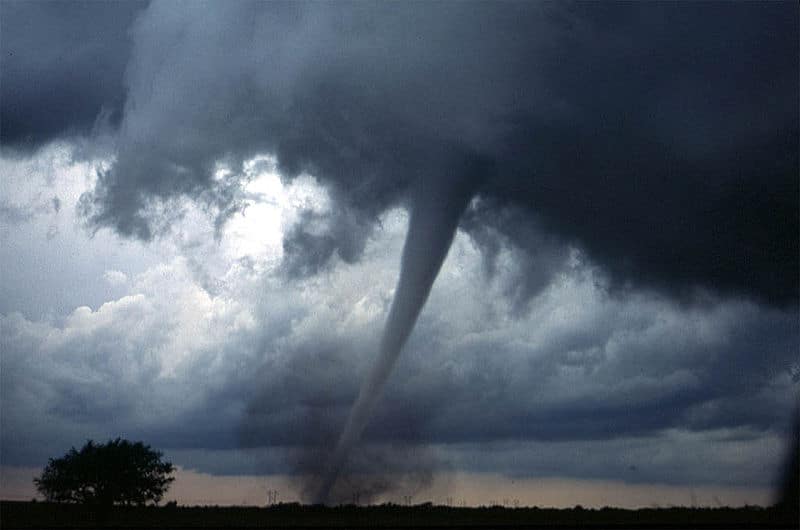
by Crystal Cockman
May 9, 2018
 On April 24, the episode of Jeopardy I was watching was interrupted by a tornado warning for Stanly and Montgomery Counties, from Morrow Mountain through Troy. This reminded of back in 2013, when there was a “straight-line” windstorm that came through that same area. Morrow Mountain was closed for quite a while as they cleaned up downed trees. I remember it vividly because it was our first thru hike of the Uwharrie Trail, and we had to clambor around lots of down trees in our final stretch of trail as we approached the Highway 24/27 trailhead. It was also July, so we were hot and tired by the end of that last day.
On April 24, the episode of Jeopardy I was watching was interrupted by a tornado warning for Stanly and Montgomery Counties, from Morrow Mountain through Troy. This reminded of back in 2013, when there was a “straight-line” windstorm that came through that same area. Morrow Mountain was closed for quite a while as they cleaned up downed trees. I remember it vividly because it was our first thru hike of the Uwharrie Trail, and we had to clambor around lots of down trees in our final stretch of trail as we approached the Highway 24/27 trailhead. It was also July, so we were hot and tired by the end of that last day.
So what is the difference between a tornado and a straight-line windstorm? A tornado is a rapidly rotating column of air that is in contact with both the surface of the Earth and a cumulonimbus cloud or, in rare cases, the base of a cumulus cloud. For a vortex to be classified as a tornado, it must be in contact with both the ground and the cloud base. Damaging winds are often called “straight-line” winds to differentiate the damage they cause from tornado damage. Strong thunderstorm winds can come from a number of different processes. Most thunderstorm winds that cause damage at the ground are a result of outflow generated by a thunderstorm downdraft. Damaging winds are classified as those exceeding 50-60 mph.
A tornado is commonly referred to as a twister, whirlwind, or cyclone. Tornadoes appear in many shapes and sizes and a wide range of colors. Most of them are in the shape of a funnel, a few hundred meters across. Tornadoes normally rotate cyclonically (when viewed from above, this is counterclockwise in the northern hemisphere and clockwise in the southern). Tornadoes can last from several seconds to more than an hour. Most tornadoes last less than 10 minutes.
A waterspout is defined by the National Weather Service as a tornado over water. Waterspouts are common along the southeast U. S. coast, especially off southern Florida and the Keys. Although waterspouts are always tornadoes by definition, they don’t officially count in tornado records unless they hit land. A landspout is a tornado not associated with a mesocyclone. Waterspouts and landspouts are very similar, as they are both relatively weak, have a small lifespan, and a small condensation funnel that does not often reach the surface.
The United States has the most tornadoes of any country, on average about 1,200 tornadoes per year. Most tornadoes in the United States occur east of the Rocky Mountains with concentrations in the central and southern plains, the Gulf Coast and Florida. Tornadoes are most common in spring and least common in winter but can occur any time during the year. They can occur at all hours of the day and night, but are most likely to occur between 3 p.m. and 9 p.m.
The most destructive and deadly tornadoes occur from supercells–which are rotating thunderstorms with a well-defined radar circulation called a mesocyclone. The most record-breaking tornado in recorded history was the Tri-State Tornado. This tornado ran through parts of Missouri, Illinois, and Indiana on March 18, 1925. It holds records for longest path length (219 miles), longest duration (about 3.5 hours), and fastest forward speed for a significant tornado (73 mph). In addition, it is the deadliest single tornado in United States history, killing 695 people.
Dr. Theodore Fujita developed a damage scale for winds, including tornadoes, which was supposed to relate the degree of damage to the intensity of the wind. The original F scale should not be used anymore, because it has been replaced by an enhanced version. The Enhanced F scale is a much more precise and robust way to assess tornado damage than the original. It classifies F0-F5 damage as calibrated by engineers and meteorologists across 28 different types of damage indicators.
In the event of a tornado, you should go to a basement or an interior first-floor room of a sturdy building, putting as much distance between you and the outside as possible, and consider putting on a helmet and shoes (in case you have to walk around in some debris). It is important to pay attention to tornado watches and warnings and be safe in conditions favorable for tornadoes to occur.